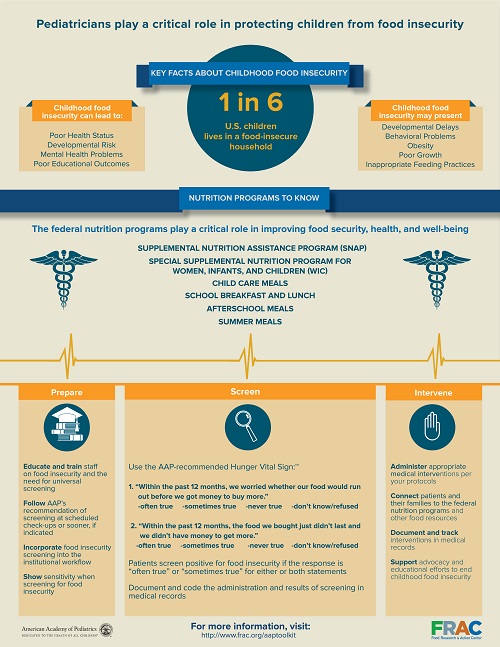Media Contacts:
American Academy of Pediatrics
Lisa Black
lblack@aap.org
847-434-7084
Food Research & Action Center
Emily Pickren
epickren@frac.org
202-640-1118
 WASHINGTON, February 9, 2017 — The American Academy of Pediatrics (AAP) and the Food Research & Action Center (FRAC) today jointly released a new toolkit, Addressing Food Insecurity: A Toolkit for Pediatricians, a comprehensive resource on how to identify and address childhood food insecurity.
WASHINGTON, February 9, 2017 — The American Academy of Pediatrics (AAP) and the Food Research & Action Center (FRAC) today jointly released a new toolkit, Addressing Food Insecurity: A Toolkit for Pediatricians, a comprehensive resource on how to identify and address childhood food insecurity.
One in six children lives in a food-insecure household. Food insecurity — the limited or uncertain access to enough food — is detrimental to child health and well-being. Study after study has shown that children in food-insecure households are likely to get sick more often and be hospitalized more frequently than their peers. Developmental delays and behavioral problems also can result, as can obesity.
Addressing Food Insecurity: A Toolkit for Pediatricians provides specific information on how to:
- screen patients for food insecurity,
- address the topic in a sensitive manner,
- make the appropriate interventions, most commonly by referring patients and their families to the federal nutrition programs, and
- advocate for greater food security and improved overall health of children and their families.
“Food insecurity is not an isolated or concentrated phenomenon, it impacts every community in the nation,” said Jim Weill, president, Food Research & Action Center. “Pediatricians are an important part of the solution to ending the problem, and this toolkit provides the information and resources needed to help ensure that no child in the U.S. goes hungry.”
Pediatricians, as well as other practitioners working with children, play a vital role in protecting children and their families from food insecurity and its harmful consequences. It is not always obvious though, even to a skilled health care provider, that a patient may be food-insecure, as the condition often is not visible. The toolkit aims to increase pediatricians’ awareness of the problem and its prevalence among American households.
The toolkit stresses the need to screen for food insecurity using a validated tool, such as the Hunger Vital Sign™. AAP has recommended that all pediatricians screen their patients using this simple, two-question tool to better identify children living in food-insecure households.
“Food insecurity is pervasive, however parents may be hesitant to talk about it due to stigma,” said Fernando Stein, MD, FAAP, president, American Academy of Pediatrics. “This toolkit provides tips and resources to help pediatricians screen for food insecurity in a practical and sensitive manner, and connect families with needed resources.”
Pediatricians can treat food-insecure patients by connecting families to resources such as the federal nutrition programs. These valuable programs, including the Supplemental Nutrition Assistance Program (SNAP); Special Supplemental Nutrition Program for Women, Infants, and Children (WIC); the Child and Adult Care Food Program; school breakfast and lunch; and afterschool and summer meals, reduce food insecurity and improve health and well-being among children.
“The federal nutrition programs help people of all ages, races, ethnicities, and life circumstances who are struggling with hunger,” said Jim Weill. “Without these programs, food insecurity in this country would be far, far worse.”
Addressing Food Insecurity: A Toolkit for Pediatricians can be found at www.frac.org/aaptoolkit.
# # #
About the Food Research & Action Center
The Food Research & Action Center (FRAC) is the leading national nonprofit organization working to improve public policies and public-private partnerships to eradicate hunger and undernutrition in the United States.
About the American Academy of Pediatrics
The American Academy of Pediatrics is an organization of 66,000 primary care pediatricians, pediatric medical subspecialists and pediatric surgical specialists dedicated to the health, safety, and well-being of infants, children, adolescents, and young adults.

